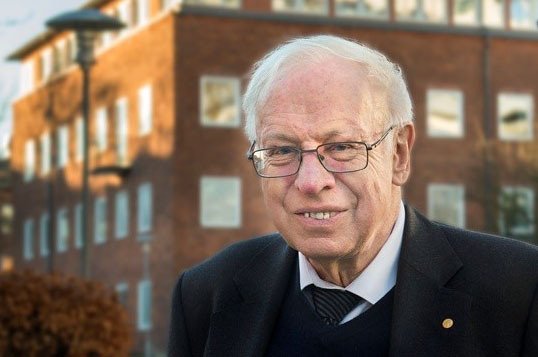Nobel Prize laureates at Karolinska Institutet
Over the years, the Nobel Prize in Physiology or Medicine has been awarded to five scientists at Karolinska Institutet.
Hugo Theorell 1955
Hugo Theorell is the violin-playing scientist who was awarded the 1955 Nobel Prize in Physiology or Medicine for his research on oxidation enzymes, substances that enable cells to convert nutrients into energy.
Read more about Hugo Theorell.
More about Hugo Theorell on nobelprize.org
Ragnar Granit 1967
Ragnar Granit, professor of neurophysiology at Karolinska Institutet, was awarded the Nobel Prize in Medicine or Physiology in 1967 for his discoveries concerning the neurophysiology of colour vision.
Read more about Ragnar Granit.
More about Ragnar Granit on nobelprize.org
Ulf von Euler 1970
Ulf von Euler was awarded the 1970 Nobel Prize in Physiology or Medicine for his work on the neurotransmitter noradrenaline and the discovery of its role in the nervous system. He did much of his pioneering research at Karolinska Institutet, where he was professor of physiology.
Read more about Ulf von Euler.
More about Ulf von Euler on nobelprize.org
Sune Bergström and Bengt Samuelsson 1982
In 1982, Sune Bergström and Bengt Samuelsson were awarded the Nobel Prize in Physiology or Medicine for their discoveries concerning prostaglandins – hormone-like substances that regulate a number of important physiological processes. Alongside their work as scientists, which has engendered several new drugs, both laureates also once presided over Karolinska Institutet.
Read more about Sune Bergström and Bengt Samuelsson.
More about Sune Bergström and Bengt Samuelsson on nobelprize.org
More on Nobel Prize laureates
 Photo: gunnar ask
Photo: gunnar askNobel Prize laureate Tomas Lindahl: “I had an excellent group at KI“
In 2015, Tomas Lindahl was one of three prominent researchers to be awarded the Nobel Prize in Chemistry. Many of his pioneering discoveries were made in a basement laboratory at Karolinska Institutet in the 1970s. It was here that he showed that DNA is not as stable as once thought – and that he described a mechanism for how cells repair genetic damage.
